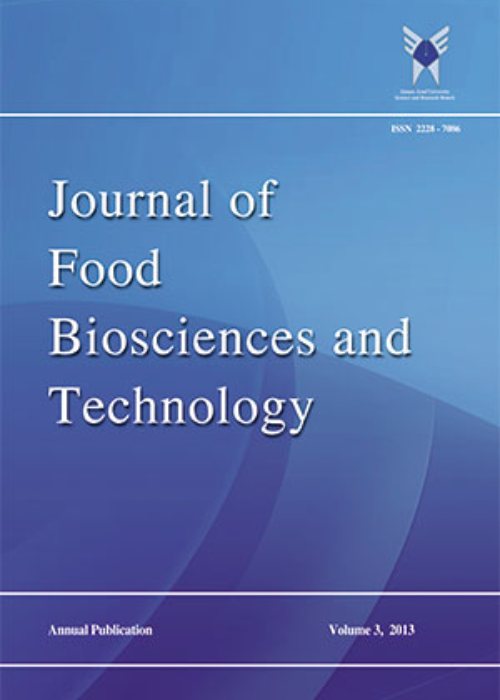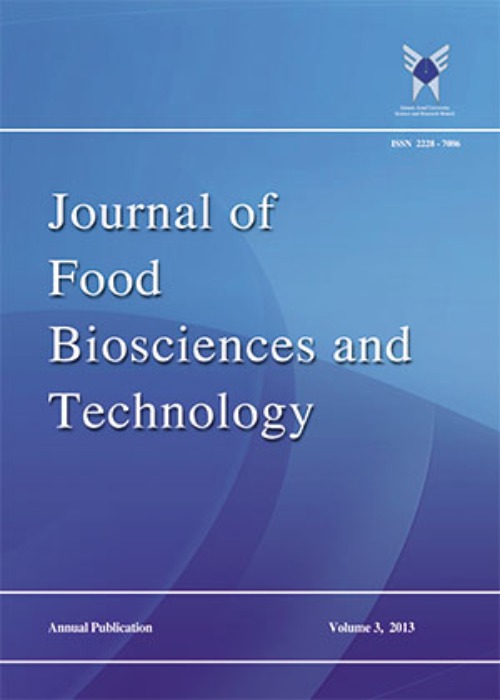فهرست مطالب

Journal of Food Biosciences and Technology
Volume:13 Issue: 1, Winter 2023
- تاریخ انتشار: 1401/09/06
- تعداد عناوین: 6
-
-
Pages 1-22In this research, nanofiltration was utilized to purify free amino acids (AAs) from sugar and colloids of sugar cane molasses (SCM) and sugar beet molasses (SBM) based on their molecular weight. The impact of temperature (30-50˚C), pressure (2-7 bar), and pH (2-11) in optimizing the purification condition was evaluated using the response surface methodology. The SCM and SBM purification results revealed the same optimum conditions in both types of molasses: 47 ˚C temperature, 3 bar pressure, and 9.3-9.5 pH. In the optimum condition, the recovery values of AAs for SCM and SBM were 66% and 63% for aspartic acid, 68.5% and 66% for glutamic acid, 84% and 69% for alanine, and 82% and 69% for lysine, respectively. The total efficiency values of four AAs and flux were obtained as 75% and 70 Lm-2h-2 for SCM and 67% and 45 Lm-2h-2 for SBM, respectively. The results indicated the suitability of the nanofiltration system's purifying function for AAs from SCM and SBM with desirable selectivity and purification efficiency.Keywords: Alanine, Aspartic acid, Dead-end filtration, Glutamic acid, Lysine
-
Pages 23-32There has been a growing increase in the consumption of Ready To Eat (RTE) vegetables among people owing to the health benefits of a diet rich in vegetables, because of hectic life styles, the use of Ready To Eat vegetables has gained popularity in recent years. RTE vegetables are subject to minimal processing and are consumed without being heat treated, they may, thus, contain human food borne pathogens. Listeria monocytogenes is one of the pathogens that has been widely reported in different outbreaks associated with the consumption of RTE vegetables. In this study the growth potential of L. monocytogenes in different types of RTE pre-cut vegetables stored at reasonably foreseen temperatures in the distribution chain of fresh produce was evaluated. Total aerobic microorganisms, lactic acid bacteria, pH and Aw were measured to characterise the vegetables. The results showed that some of the tested products (grapes, tomato, white cabbage and red cabbage) had a growth potential (δ) higher than 0.5 Log10 (CFU/g) during their shelf life and can therefore, support the growth of Listeria monocytogenes. By way of conclusion, conducting different challenge tests in the factories producing these convivence products seems of great importance.Keywords: growth potential, Listeria monocytogenes, RTE Vegetables
-
Pages 33-52Argan oil extracted from the fruit of Argania Spinosa L. has many nutritional and therapeutic properties. This study was conducted to investigate the effect of Argan kernel roasting on physicochemical properties of cold-pressed oil. In this study, Argan kernels were roasted at 110 ° C for 30 minutes, and Argan oil was extracted from unroasted and roasted kernels by cold pressing. The results showed that in the oils extracted from unroasted and roasted Argan kernels, the predominant fatty acid was oleic acid and then linoleic and palmitic acids, respectively. γ-Tocopherol made up more than 80% of the tocopherol compounds in the samples, and spinasterol (78.44% in unroasted and 47.35% in roasted samples) were the predominant sterol compound of Argan oil. The sterol compounds of schottenol (38.69%), chlorophyll (0.43 ppm) and carotenoid contents (15.2 mg/kg) in oil extracted from roasted Argan kernels were higher, and there was no statistically significant difference (p < 0.05). According to the results, the oil extracted from roasted Argan kernels could be considered as a product with more desirable organoleptic properties and higher oxidative stability than the oil extracted from unroasted kernels during storage.Keywords: Argan Oil, Carotenoids, Chlorophyll, Fatty Acid Composition, Tocopherol
-
Pages 53-60Medicinal plants are considered as valuable natural sources. In this study, the antibacterial properties of Cirsium congestum essential oil and methanolic extract were investigated against Escherichia coli, Bacillus cereus, Staphylococcus aureus, Candida albicans and Klebsiella pneumonia. The results of agar disc-diffusion method showed that essential oil and extract exhibited maximum and minimum inhibition zone diameter against Candida albicans and Escherichia coli respectively. Minimum inhibitory concentration (MIC) of essential oil and methanolic extract observed for Staphylococcus aureus, Escherichia coli, Bacillus cereus, Candida albicans and Klebsiella pneumoniae respectively. Lowest MIC related to Candida albicans. Cirsium congestum essential oil had higher antibacterial activity in comparison with the extract. The chemical composition of the Cirsium congestum essential oil was analysed by gas chromatography mass spectrometry (GC–MS). Twenty-six compounds representing 99.98% of the total essential oil was identified. The Results showed sescoe turpen hydrocarbons and imidazole 4- propionic acid were the major compounds in Cirsium congestum essential oil.Keywords: Antibacterial, Cirsium congestum, Essential Oil, Extract, GC-MS
-
Pages 61-74Honey has various attributes according to its plant origin and production area. The aim of present study is to investigate physicochemical and biological functions of astragalus and thyme honey in Damavand and Izeh regions. Honey identification was analyzed on base of their physicochemical activities such as water content, ash, total solids, total soluble solids, pH, acidity, total sugar, reducing sugar, sucrose, fructose to glucose ratio, diastase activity, hydroxymethylfurfural (HMF), viscosity, total phenols, flavonoids and antioxidant behavior. The results of tests such as moisture content (16.16 to 19.08 %), ash (0.49 to 0.59 %), total solids (80.93 to 83.85 %), total soluble solids (80.25 to 81.74 %), pH (4.20 to 4.66), acidity (21.80 to 23.14 mEq / kg), total sugar (72.74 to 73.63 %), reducing sugar (69.26 to 73.07 %), sucrose (0.50 to 3.48 %), fructose to glucose ratio (1.06 to 1.31 %), diastase activity (8.63 to 10.13 DN), HMF (4.7 to 11.06 mg / kg), viscosity (21940 to 24705 cP), total phenolic compounds (23.96 to 30.03 mg gallic acid / 100 g honey), flavonoids (12.31 to 17.24 mg catechin / 100 g honey) and antioxidant activity (44.96 to 52.89 %) were determined. The results of simple correlation analysis illustrated parallel, positive and very strong relationship between 2,2-diphenyl-l-picrylhydrazyl and ash attributes, total phenolic compounds, total sugar, fructose to glucose ratio and also flavonoids.Keywords: Antioxidant Activity, DPPH, Damavand, Honey, Izeh
-
Pages 75-89This study aimed to evaluate the effect of enzymatic hydrolysis of Spirulina protein on the solubility, emulsifying activity index (EAI), emulsion stability index (ESI), and DPPH and ABTS radical scavenging activity of extracted peptides. The molecular weight of spirulina protein was determined using the SDS-Page technique. The extracted protein was hydrolyzed by alcalase enzyme and the degree of hydrolysis (DH%) was determined after 2-12 h. Functional properties and antioxidant activities of extracted protein and hydrolyzed proteins were evaluated. The concentration of extracted protein was 108 mg/L and the protein content of Spirulina was 54% (w/w). Most of the protein bands were in the molecular weight range of 15 to 20 kDa, and the DH reached from 4.2 ± 2.1% to 14 ± 1% after 10 h of enzymatic hydrolysis. The lowest solubility was recorded for the extracted protein at pH of 4, and the highest was related to the 14% hydrolyzed protein at pH of 8. Moreover, the extracted protein had higher EAI and ESI than hydrolyzed proteins, and the effect of pH was more evident on the EAI of hydrolyzed proteins compared to ESI. The present study showed that the antioxidant activity of the protein increased with increasing degree of hydrolysis and its concentration. Moreover, the protein with a DH of 14% in all concentrations had the highest inhibition. This work presented that the current method used for extraction and enzymatic hydrolysis of spirulina protein led to the production of peptides that have desirable properties for use in the food industry.Keywords: Antioxidant Activities, Protein Hydrolysate, Solubility, Spirulina


